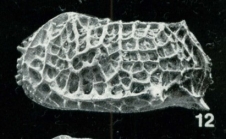WoRMS taxon details
Bradleya pseudodictyon Whatley, Downing, Kesler & Harlow, 1984
776384 (urn:lsid:marinespecies.org:taxname:776384)
accepted
Species
marine, fresh, terrestrial
Whatley, R.C., Downing, S.E., Kesler, K. and Harlow, C.J. (1984a) New species of the ostracod genus Bradleya from the Tertiary and Quaternary of D.S.P.D.P. sites in the southwest Pacific. Revista Espanola de Micropaleontologia 16, 265–298. [details]
Type locality contained in Marshall Islands
type locality contained in Marshall Islands [details]
Description Small to medium. Elongate, sub-ovate to subrectangular. Anterior margin broadly rounded, posterior truncate to weakly...
Etymology L. Referring to the close similarity of this species to B. dictyon (Brady) 1880
Description Small to medium. Elongate, sub-ovate to subrectangular. Anterior margin broadly rounded, posterior truncate to weakly caudate. Dorsal margin straight without prominent hinge ears; ventral margin straight to gently convex. Sexually dimorphic males lower than females. Reticulate. Ventro-Iateral carina of high relief, narrowing posteriorly and terminating in a prominent laterally directed spine. Remainder of valve surface non-spinose. Ocular ridge well-developed, sinous. Dorsal carina of equivalent relief to remainder of reticulum. Muri of moderate relief rounded, equally developed both anteriorly and posteriorly. Posterior reticulum with a subquadrate group of 4 fossae, the bounding muri of this group being of equal horizontal and vertical emphasis. Fossae subdivided by virtually aligned secondary muri. Bridge sub-rectangular. Weakly foveolate. Normal pore canal distribution as for the genus, solar sieve pores celate. Juvenile ins tars lightly calcified with highly developed secondary reticulation. All internal details as for the genus, posterior terminal tooth of RV only indistinctly lobate. [details]
Etymology L. Referring to the close similarity of this species to B. dictyon (Brady) 1880
Etymology L. Referring to the close similarity of this species to B. dictyon (Brady) 1880 [details]
Brandão, S. N.; Antonietto, L. S.; Pereira, J. S.; Pereira, S. G. G.; Sá, H. A. B.; Praxedes, R. A.; Sabater, L. M., Santos, S.G.; Karanovic, I. (2025). World Ostracoda Database. Bradleya pseudodictyon Whatley, Downing, Kesler & Harlow, 1984. Accessed through: World Register of Marine Species at: https://www.marinespecies.org/aphia.php?p=taxdetails&id=776384 on 2025-06-02
Date
action
by
![]() The webpage text is licensed under a Creative Commons
Attribution 4.0 License
The webpage text is licensed under a Creative Commons
Attribution 4.0 License
Nomenclature
original description
Whatley, R.C., Downing, S.E., Kesler, K. and Harlow, C.J. (1984a) New species of the ostracod genus Bradleya from the Tertiary and Quaternary of D.S.P.D.P. sites in the southwest Pacific. Revista Espanola de Micropaleontologia 16, 265–298. [details]
 Present
Present  Present in aphia/obis/gbif/idigbio
Present in aphia/obis/gbif/idigbio  Inaccurate
Inaccurate  Introduced: alien
Introduced: alien  Containing type locality
Containing type locality
From editor or global species database
Description Small to medium. Elongate, sub-ovate to subrectangular. Anterior margin broadly rounded, posterior truncate to weakly caudate. Dorsal margin straight without prominent hinge ears; ventral margin straight to gently convex. Sexually dimorphic males lower than females. Reticulate. Ventro-Iateral carina of high relief, narrowing posteriorly and terminating in a prominent laterally directed spine. Remainder of valve surface non-spinose. Ocular ridge well-developed, sinous. Dorsal carina of equivalent relief to remainder of reticulum. Muri of moderate relief rounded, equally developed both anteriorly and posteriorly. Posterior reticulum with a subquadrate group of 4 fossae, the bounding muri of this group being of equal horizontal and vertical emphasis. Fossae subdivided by virtually aligned secondary muri. Bridge sub-rectangular. Weakly foveolate. Normal pore canal distribution as for the genus, solar sieve pores celate. Juvenile ins tars lightly calcified with highly developed secondary reticulation. All internal details as for the genus, posterior terminal tooth of RV only indistinctly lobate. [details]Diagnosis Elongate, subrectangular to subovate and weakly caudate species of Bradleya with welldeveloped reticulum. Muri distinct, rounded, of approximately equal development across both the anterior and posterior reticular fields. Dorsal carina of equivalent relief to the other muri; bridge strong, sub-rectangular. Juvenile instars lightly calcified with subdued primary but well developed secondary reticulation. [details]
Etymology L. Referring to the close similarity of this species to B. dictyon (Brady) 1880 [details]









